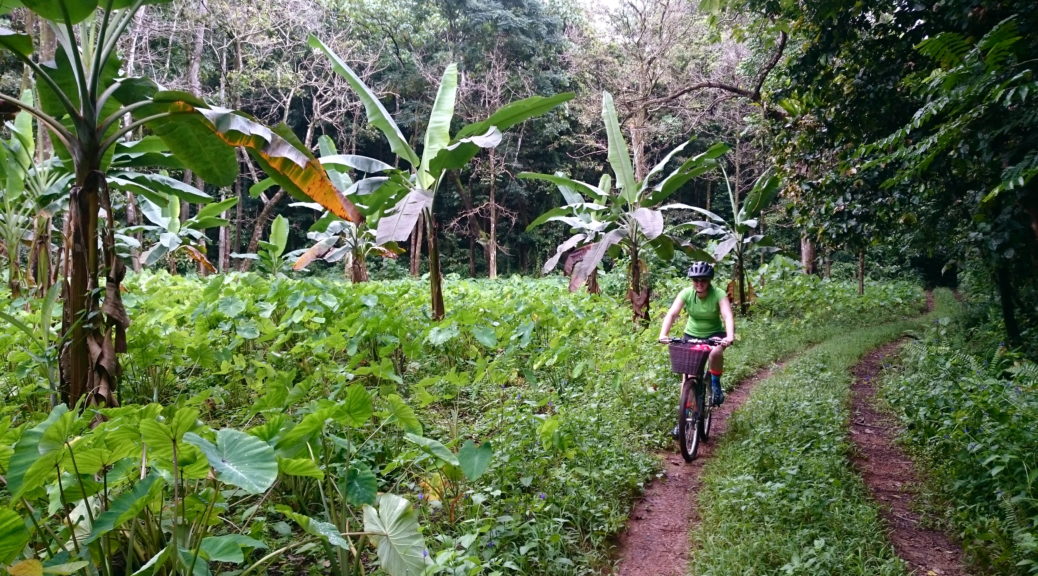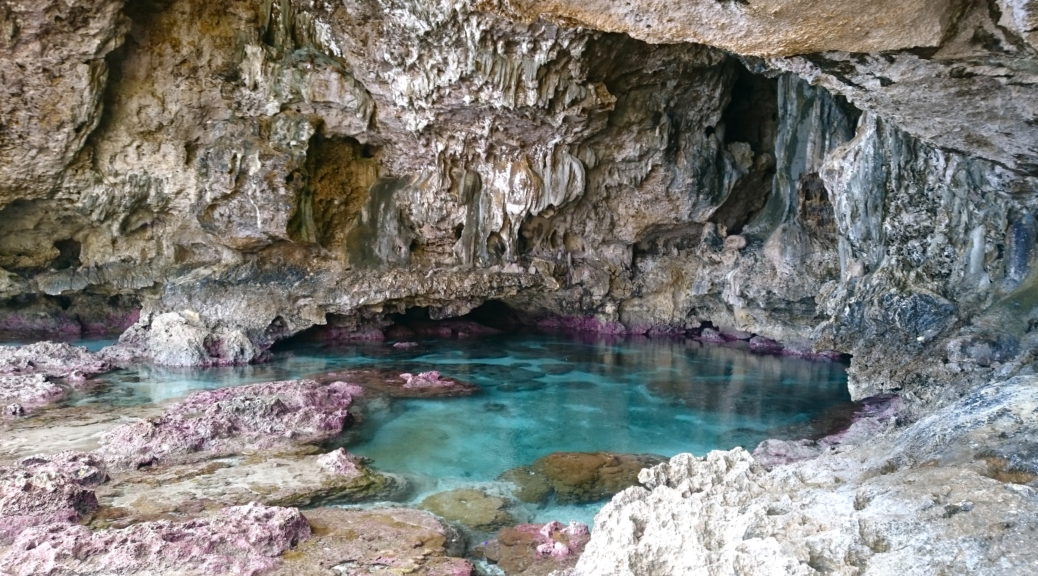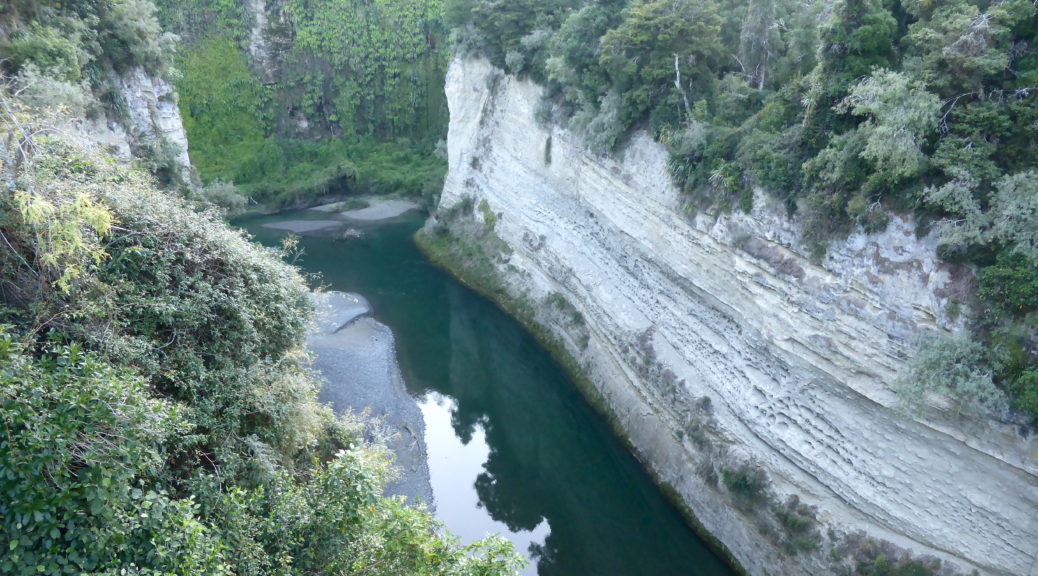It didn’t take long for me to assemble my bike, but finding the time in the busy swimming, snorkelling and eating schedule was a different matter. Adele was also keen to explore a little by bike (i.e. get around the island without being confined to a damp, musty van with suspension that groaned with every pothole – of which there were multitudes). So Wednesday morning, she borrowed a bike, with fetching basket, from her friends and set off to follow one or two of the designated cycle routes.
I’d done just enough research to learn that there had been some small effort to attract cyclists to Niue to ride various small loops of main roads (quiet), back roads (even quieter) and jungle tracks (quietest). With the map of island in hand we set off to cross the island and form a couple of small loops. Leaving the main road and the coast, it was straight into a steep climb up to a transmitter tower and onto the plateau.
Soon we were on dirt tracks getting deeper into the jungle. At times we passed small patches of cultivation and the occasional dwelling. Apart from dense tropical jungle, little seems to grow around here. The small fields mostly contained more taro than I would ever care to contemplate.

Joining the sealed road that approximately bisects the island, we headed east to find the Vinivini bush track. The trees were a bit larger through here, even less traffic was to be found and only one pack of dogs – they were rather worrying, but. We reached the trailhead and were surprised to see a car (obviously a rental) parked there – would we actually see other people? It threatened to rain, but was generally warm and humid.

 We found more taro, and even a bit of papaya. The one we picked didn’t last so well in the basket.
We found more taro, and even a bit of papaya. The one we picked didn’t last so well in the basket.
Trail marking wasn’t great, but we’d preloaded maps onto our devices and could mostly work out where we were supposed to be going. After taking the obvious, clear track at one point it quickly terminated at another taro patch. So that left a partially overgrown path to take – plenty of fallen trees to ride around, lift bikes over and tall scrub (not of the stinging variety) to bash through. A little bit of adventure in what was generally a sedate ride. The trail was clear under the canopy, but anywhere the foliage on the ground got light – it was a little out of control.
 I found something to clamber over and #bikesrestingagainstearthmovingmachinery.
I found something to clamber over and #bikesrestingagainstearthmovingmachinery.
 With the briefest of showers, we reached the end of the trail and joined the perimeter road.
With the briefest of showers, we reached the end of the trail and joined the perimeter road.
A leisurely hour took us back across the island, past the schools and university campus (?!), and I had to take a peek at the island’s power station – one diesel generator and a decent solar array. I think I earned my two rotis for lunch from that pleasant little outing.


Determined to at least ride around the island once (it’s only logical), the following morning seemed good as the McKirdys were off on a fishing charter catching dinners for subsequent nights. Once again, the roads were deserted and I found for the most part riding was just as fast as driving. Giant and numerous potholes are far more easily avoided on a bike – and there’s not really any need to slow. Weaving through the obstacles I continued in a clockwise direction, avoiding more annoying (and sometimes worrying) packs of medium-sized dogs. They did me no harm, but after encountering dogs while riding in other countries wariness accompanies me.

 Plenty more derelict houses peppered the sights of the jungle.
Plenty more derelict houses peppered the sights of the jungle.
About two-thirds of the way around, along the rugged and even-more-deserted east coast, I found the trail to Togo Chasm. A wide walking trail through lush and unspoilt jungle, I tried riding it for a few hundred metres; alas, it was covered in too many slippery roots and rocks. The pleasant stroll under the canopy deposited me on top a large section of uplifted fossilised coral. The path descended to the top of the chasm and a ladder built for giants descended to the sand below. Sheltered from the Pacific crashing nearby, in this still and sheltered area a few coconut trees had thrived. I enjoyed the peace for a bit before climbing the ladder out.



 My bike had not been consumed by the tropical forest in the time I was away.
My bike had not been consumed by the tropical forest in the time I was away.
Unfortunately the rain returned and, strangely for the daytime, set in. It was still warm and interesting riding – just plenty wet! So no more riding photos; as I went around the south of the island the remoteness faded and I was soon passing the only resort. Thankfully, the main road headed inland and the perimeter road went back to being deserted. Nearing Alofi, I found what came closest to being an industrial area – the island’s tip, a quarry, and container compound. It was curious to see a large barge, on wheels, deposited next to a playground surrounded by isotankers – I guess that’s how all the fuel comes in.
I found the others at the Crazy Uga Cafe. It was nice to be out of the rain and get some hot food. The day’s spectacle was the tying up of the monthly-freighter. With the wharf not having a sufficiently deep berth, the small ship had to be tied up out in the bay. What goods was this ship bringing, would they backload empty containers? Just how were they going to get the containers off? That last question at least was soon answered as a very large front-end loader roared down the road towing the aforementioned barge behind it. Over the following days the combined effort of two cranes, a pilot vessel/tug, the barge and the ship’s own crane transferred a series of containers between the ship and shore. It’s a nice reflection of the slow pace of island life that this was quite the spectacle and going-on.


So a couple of nice little rides had me seeing much of the island. I never got around to zig-zagging my way down the centre of the island – but the weather was far more conducive to swimming and there was much to be seen underwater. In that light, it probably wasn’t worth taking my own bike (although that’s always nice) – I could have easily borrowed one and had a less comfortable and reliable adventure!


 First explore – down the cave near Adele & James’s accommodation. There are a lot of limestone caves around the shore.
First explore – down the cave near Adele & James’s accommodation. There are a lot of limestone caves around the shore. A smattering of ferns down said-cave.
A smattering of ferns down said-cave. Happy not to climb down there into the surging ocean. Nice and clear, but.
Happy not to climb down there into the surging ocean. Nice and clear, but. A twenty or so minute walk through the jungle led us down to Talava Arches.
A twenty or so minute walk through the jungle led us down to Talava Arches. Looking out through and to Tavala Arches.
Looking out through and to Tavala Arches. Exploring the flats between the arches at low tide.
Exploring the flats between the arches at low tide. Typical jungle walking.
Typical jungle walking. Walking out through Palaha Cave to the sea.
Walking out through Palaha Cave to the sea. Looking out across to the edge of the reef.
Looking out across to the edge of the reef. A shower has passed. Those tsumani evacuation signs look familiar. Also shown: the general state of the few roads – that is, poor.
A shower has passed. Those tsumani evacuation signs look familiar. Also shown: the general state of the few roads – that is, poor. Near the end of the week, the sky cooperatively cleared for some decent sunsets.
Near the end of the week, the sky cooperatively cleared for some decent sunsets.
 Tamakoutoga Beach – one of the few sandy ones.
Tamakoutoga Beach – one of the few sandy ones. More beautiful pools at Avaiki Cave, and rather unconvincing proof that I did actually go in the water.
More beautiful pools at Avaiki Cave, and rather unconvincing proof that I did actually go in the water. John appreciating that Avaiki looks even better when the sunlight is shining directly into the entrance of the cave.
John appreciating that Avaiki looks even better when the sunlight is shining directly into the entrance of the cave. Avaiki Cave had something approaching a mezzanine level, good fun clambering up there and checking out the formations from a different perspective.
Avaiki Cave had something approaching a mezzanine level, good fun clambering up there and checking out the formations from a different perspective.

 Back to Matapa Chasm; this one has some fresh water flowing in so is cooler – but this time we had the sun directly overhead warming us, perfect.
Back to Matapa Chasm; this one has some fresh water flowing in so is cooler – but this time we had the sun directly overhead warming us, perfect. James up yet another coconut tree.
James up yet another coconut tree. Coconut catching was well practiced by this stage.
Coconut catching was well practiced by this stage. Final swim was at Limu Pools, especially good.
Final swim was at Limu Pools, especially good.
 In the meantime I occasionally looked back over Hawke’s Bay while making my way through the copious amount of food I’d packed for a day with no services.
In the meantime I occasionally looked back over Hawke’s Bay while making my way through the copious amount of food I’d packed for a day with no services. Looking over to the northern reaches of the Ruahine Ranges.
Looking over to the northern reaches of the Ruahine Ranges. Te Manihi (1099 m) – just before dropping down to the popular Kuripapango campground and crossing the headwaters of one of the big Hawke’s Bay rivers, the Ngaruroro.
Te Manihi (1099 m) – just before dropping down to the popular Kuripapango campground and crossing the headwaters of one of the big Hawke’s Bay rivers, the Ngaruroro. It doesn’t look too steep, but this convoy of caravans stopped as they were cooking their brakes.
It doesn’t look too steep, but this convoy of caravans stopped as they were cooking their brakes. Kaikomata Range.
Kaikomata Range. The views of Ruapehu were excellent, I was surprised by how much snow was up there already.
The views of Ruapehu were excellent, I was surprised by how much snow was up there already. The road quickly dropped down to the mighty Rangitikei River. And reared steeply out of the valley, probably the toughest climb all day – it was a bit of a grovel.
The road quickly dropped down to the mighty Rangitikei River. And reared steeply out of the valley, probably the toughest climb all day – it was a bit of a grovel. A nice little climb to warm up deposited me into this colourful scene.
A nice little climb to warm up deposited me into this colourful scene. I soon dropped sharply to cross the Rangitikei again, riding over a deep and narrow gorge.
I soon dropped sharply to cross the Rangitikei again, riding over a deep and narrow gorge. Out of that valley I soon found a sublime patch of gravel winding its way through farms littered with golden trees and dropping into the next valley, the Kawhatau.
Out of that valley I soon found a sublime patch of gravel winding its way through farms littered with golden trees and dropping into the next valley, the Kawhatau. Ruapehu popped up again.
Ruapehu popped up again. Watching and listening to dogs mustering sheep was about the most activity I saw all morning.
Watching and listening to dogs mustering sheep was about the most activity I saw all morning. Native forest! Maybe I’d climbed just a little.
Native forest! Maybe I’d climbed just a little. An Event sign, hmmm, what could be going on?
An Event sign, hmmm, what could be going on? One just has to stop for a sign this long.
One just has to stop for a sign this long.